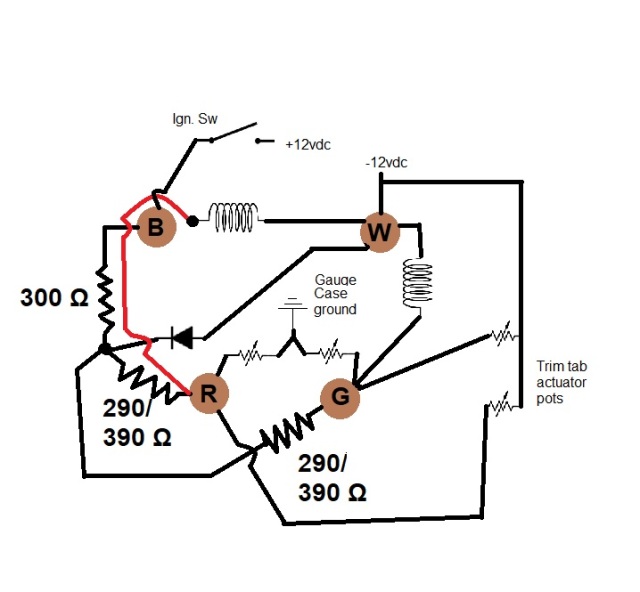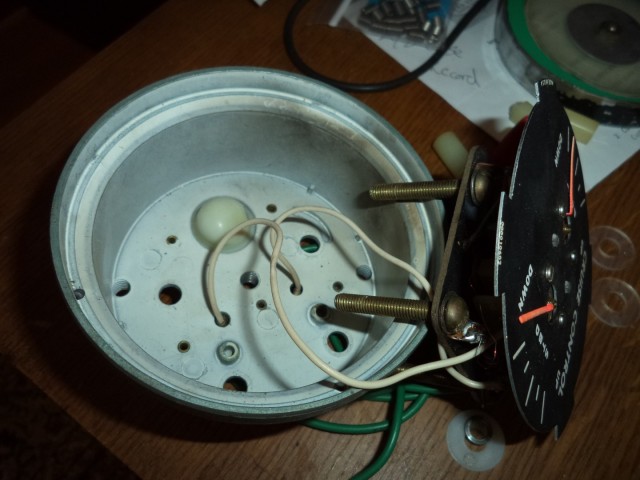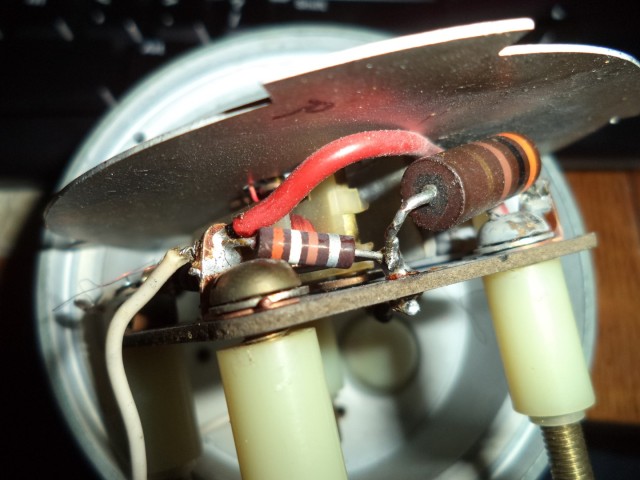Like the swim platform, raw water intakes for the main engines, the Panda genset, and the air conditioning systems, since the trim tabs are under the waterline, I want them functional and sealed water-tight when the boat splashes.
Longtime readers will remember way back in 2013 when I made patterns for replacement trim tabs. A highly paid “professional” fabricator had previously taken mine back to his shop, then either threw them away or lost them. In 2016, I partially installed the new stainless steel trim tabs, basically just applying caulk and bolting them up to the original locations, without connecting the actuators or wiring. At the same time, I disassembled the “Roamer Cruise Control” gauge, which is basically a set of trim tab angle indicators, and found some components inside had “let the smoke out.” Fast forward to October 2022, and I thought I’d see if I could wrap these things up.

Port tab easily connected to the actuator shaft

Starboard tab’s actuator pin was welded on crooked
It’s only a few degrees off, but that matters. It’s amazing to me how consistently incompetent the marine contractors are in my area.

I put a large wrench on the tab and bent it into position

The pivot pin wouldn’t go fully through the actuator shaft, so I had to redrill the hole

I was finally able to connect the starboard tab and actuator shaft

Next, I applied bottom paint
I didn’t put bottom paint on the trim tabs because in my experience bottom paint quickly falls off of stainless.

Trim tabs are done on the outside

On the inside, the “Roamer Cruise Control’ actuators could use a cleaning
The motors, gearboxes, and jackshafts worked fine. They just needed to be cleaned and re-greased.

I’m not keen on that gap between the gearbox and mount

I added two washers to fill the gap

The gearbox screws are a very unique design
These two screws hold each gearbox in position. Unfortunately, I lost track of one of the screws for the starboard actuator. For years, I’d been looking for it on the boat and in my garage.

The screw head fits inside the hole in the mount with a couple thousandths of an inch clearance
With only one screw in place, the gearbox twists out of alignment. With a replacement screw that isn’t the exact same size and shape of the original (even if it threads into the hole in the gearbox just fine), the gearbox twists out of position, though not as badly as with only one screw.
I was at the point of taking one of the screws to a machine shop to see if they could replicate it when–lo and behold–I found the wayward screw under some plywood scraps I was saving in the aft stateroom!

It was absurd, the joy I felt at finding this little bugger

I probably should have noted which wires go where
The Roamer Cruise Control gauge at the helm gets the signal for the angle of the tabs from this gear-driven rheostat that rotates when the actuator jackshaft turns either direction. There are three wires coming off the rheostat but only two wires coming from the helm gauge for the actuator on each side.
Fortunately, a fellow Roamer 46 owner was able to snap some pictures of the connections and that got me back in business.

With the electrical connections figured out, I painted the motors

I wrapped up the actuators with new shrink connections where necessary and cable loom for the wires
Next, I moved on to the helm switches.

Swapping wires from the original switches to new ones
The original switches were mechanically fine but ugly. New Cole Hersey nickel-plated DPDT momentary-on switches look much better.
Next, I tried to tackle the Cruise Control gauge.

The Roamer Cruise Control gauge

Inside, it was mostly intact
These resistors appear to have red, white, brown, and silver bands, which makes them 290 ohms ±10%. Or that first band could be orange, which would make them 390 ohm.

Alas, this resistor vigorously ‘let the smoke out’
With so little of the resistor remaining, it’s impossible to know what ohm value it was. What’s clear is that something really bad happened inside this gauge.

The varnish also got cooked off of the super-fine coil wire here
The wire still has continuity, which is pretty amazing given what happened to the resistor. I coated the coil wire with clear enamel spray paint to restore something like the original varnish insulation.

I dug through a box of resistors and found a close replacement
This is a much larger resistor, which means it can handle more power without degrading. The bands are orange, black, brown, and gold, which makes makes it 300 ohms ±5%.
When I put 12v to the pins I (fortunately) marked B & W, then grounded the pin for the starboard angle indicator in the gauge, the needle immediately went to the pin stop in the UP position. I repeated the process for the port gauge, and the same thing happened. So the mechanisms are working. But when I took it to the boat and put jumper wires on all of the connections, the needles stayed dead regardless of whether the tabs were full up or down.
I disconnected the gauge from the boat wiring and put 12v+ to the center pin on an incandescent bulb. I then put a jumper wire from the actuator rheostat signal wire to the ground connection for the bulb. When I cycled the tabs up and down, the bulb correspondingly got brighter or dimmer. Which I think means the rheostat is sending the proper signal.
I took the gauge back home and tried some different approaches to see if I could make it work. A daisychain of resistors on the 12v supply, effectively dropping the supply to 9vdc, finally got the needle to move a bit without slamming into the UP stop pin.

Finally, subtle needle deflection

Same on the port side
I’m stumped. The tabs work fine, so they’re not holding me up from splashing or driving the boat. But it would be nice to have a working Cruise Control gauge. Off the boat, I can trick the gauge into sort of working. On the boat, the needles don’t move, though incandescent bulbs DO grow brighter and dimmer based on the tab position. It seems like the gauge should work, but it doesn’t.
If anybody knows of a Roamer on Purgatory Row of a boatyard somewhere with this Cruise Control gauge, I’d be interested in buying it. And if anybody knows the value of that resistor that got smoked, please let me know in the comments!
Next up in our 1969 Chris Craft Roamer 46 Refit: Wrapping Up the Salon Entry Door
???
what resistance values do the pots have at the extreme range of the tab positioning.
What do the 290Ω/390Ω resistors each measure?(the meter may affect he reading)
When you had 25% indication on the bench, what was the r/g wire connected to? I assume that 300Ω was also in play.
I notice a diode amidst the parts. I assume that is to prevent reverse voltage from causing negative meter deflection.
Correct me if the following is correct.
one end of each rheostat is connected to a common ‘groundbus’.
the other end is connecved to the r/g terminal.
It would be useful to know IF the small resistors are connected parallel with the meter leads or something else. Possibly in series with something else?
Give me some time to pull answers together for your questions. Thanks so much for the help!
I think I got everything right here.

WELL THAT EXPLAINS THE SMOKE! +/- CONNECTED BASS ACKWARDS.
Curious re the pots to case ground. Also curious re case ground to possible -12v connection. ==== neutral buss????
Still need trim tab rheostat resistance at end positions(full up/full down) Still deciphering your resistor readings.
Key ? When you got that 25% indication, what was connected between r/g terminals and -12?
I assume you applied 12v across +12v and -12v?
What did you change to get each (p/s) separate indication?
Still need trim rheostat values.
I won’t be able to get the pot values at the actuators until later this week. Stay tuned.
Could you elaborate on “+/- CONNECTED BASS ACKWARDS”?
The wiring standard back in the day was black = 12v+, white = 12v-. So I presumed the B pin should be +12v and the W pin -12v.
Here are some pix of the case grounded pots and the white wires that connect them to the R and G pins.

The internal diode provides a path from the smoked resistor to terminal W. IF the voltage polarity were reversed, the smoke would appear. I presume thst is ewhat happened.
Is it possible(likely?) that the case is connected to terminal W by way of no insulating washer between the case and the terminal nut? That would put them in parallel with the coil, plane positioning pot(down below) and provide a calibration method.
Close look at the raising/lowering stuff reveals the positioning pots are 50Ω. Do the two wires going to the gauge connect to the center pot terminal and one of the outer terminals. Does one of those wires effectively connect to terminal W(the other connects to R or G terminal).
Is it accurate that when you got that 25% indication the only external connections were +12v to terminal B and -12v to R/G terminal? If not, what?
I am suspicious that the 290/390 resistors may actually be 190Ω resistors(brown/white/brown).
OVER
Thanks James!
I don’t recall exactly which wires were connected to what when I got the needles to deflect 25%, but I’d guess it was +12 to B, -12 to W, and a jumper connecting W to R and G.
I’ll get answers to your questions in the next few days.
I dunno about the brown/white/brown theory. That first band sure looks orange or red to me…definitely not the same color as the 3rd band.

The 290Ω/390Ω resistors measure 99 and 105, as installed in the gauge. The new one I installed measures 334.
Q, there should be a shunt, which steps down the voltage to the gauge, check to see if it’s intact and working properly. I smoked the ammeter on our Airstream, when I got rid of the original Univolt charger/converter, in favor of a new system. NyCo restored my ammeter and also made it so that it would work with the new Iota converter/charger. Here’s their website, they’re phenomenal: https://www.nyco-systems.com/
Hmmm. If there was a shunt, I have no idea where it would be. When I removed it from the helm back in 2008, I marked the four terminals B, W, R, and G.
B and W are 12v + and -, with the + side coming from the ignition. So the gauge is on anytime the ignition is on. There’s no shunt between the ignition switch and the connector for the gauge.
Green and Red were the signal return lines from the port and starboard rheostats, which are fed from the neutral bus.
If you don’t mind me asking, what did they charge you to resolve your ammeter problem?
$150…this was in 2009, and worth every penny.
That seems fair.
Can you create a schematic? Maybe some of us EE types can figger it out. Key will be gthat partial deflection and effective rheostat setting/range
Thanks for the suggestion! My attempts to create schematics thus far have turned out pretty ugly. I’ll play around with some apps and see if I can come up with something that works.
Stay tuned!
A cru..simple scribble version will suffice.
Consider swapping in a rheostat for the blow resistor. Use it to tune the gauge, then measure the resistance.
Thanks, Mike! That’s a great idea!